Chapter 32
The Sunset Drive-In
The Sunset Drive-In

The marquee did not look much better than this when I worked there.
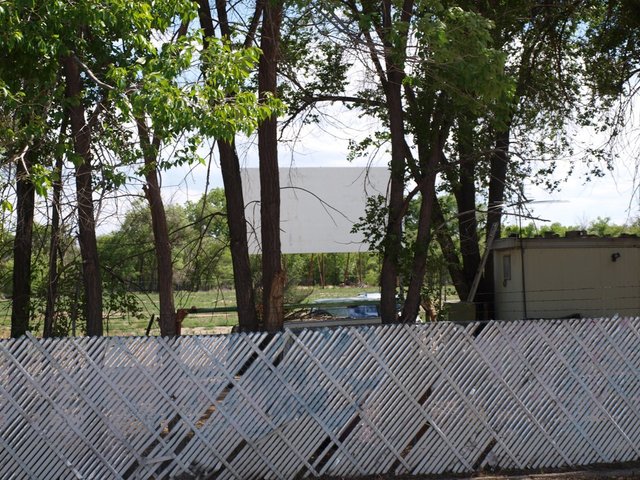
You can see a corner of Mario’s mobile home in the foreground.
THE SUNSET DRIVE-IN.
Rudy Napoleon told me that the Sunset had just lost its projectionist and that I should apply.
That was almost certainly on Sunday, 1 April 1984.
If so, that was the second April Fools’ Day that played a prank on me.
So, that night, I took some buses and transferred to the Isleta bus
got off at Isleta and Arenál.
It suddenly started raining.
I walked the couple of blocks from the stop, in the dark, in the rain, and arrived soaking wet.
One of the two owners, John Michael Servizio, was in the booth, watching over his new recruit,
a young, nice, but incoherent and inept guy who was one of those people you would never want to put in charge of anything.
He was a klutz. He could not get better. I have nothing against people like that.
I can enjoy their company and have friendly conversations with them.
We can have our laughs together.
There are places in society for people such as he, but one of those places is not a projection booth.
John asked me to run the next reel,
and so I pulled the next 2,000' reel out of the bin and laced it up in a couple of seconds,
as he marveled at my skill and said to the young guy:
“Look how he does that!”
I had the job.
No further interview.
From that night on, John often called me “my angel walking in the rain.”
A couple of days later, which, I now discover, must have been Wednesday, 4 April,
I visited Rudy in his booth to thank him for the lead,
but he was deeply worried, and before I could thank him, he said,
“Oh, I hope you didn’t take that job!”
I was confused.
“That guy’s a murderer! It was in the paper!
I thought, ‘Oh, what did I get you into?’”
Well, that wasn’t the most comforting news in the world.
The next day, I paid a visit to the newspaper office downtown to see if I could get the story about my new boss.
ABSOLUTELY NOT!!!!!!!
Once the next day’s newspaper is published,
the previous day’s paper is strictly confidential and may never be shown to anybody ever again.
I would have to search about through people’s trash baskets if I hoped to find the story.
I was totally confused.
Why?
Though the clerks would not spell it out clearly, they cryptically hinted enough for me to put the story together:
If a newspaper office shows a previous edition to anyone from the public, that is considered a new publication,
and any actionable statements would have the statute of limitations begin rolling again from Day One.
Oh.
I asked if I could chat with any reporters on the police beat.
They pretended not to know what I was talking about.
I had no idea what to do.
Yes, I could have gone to the library, but which issue was I looking for?
Which page? Which article?
There was no index.
I should have asked Rudy to tell me what day that article appeared.
Why didn’t I?
Not too bright, am I?
In much more recent years, now that old newspapers are online and somewhat searchable, I found the relevant articles,
or at least some of them.
Now, when I tell people about the adventures I have lived through, NOBODY ever believes me.
Actually, people get worried, they get nervous because they think I must be certifiably insane and possibly dangerous.
More charitably, some of think I’m merely being childish in my endeavors to get attention or to shift the blame.
Typical reaction: “Oh you’re so paranoid! Please! Knock it off!
You’re delusional. That never happened! Come off it!”
Okay, below are some of my paranoid delusions that never happened,
and some of my attention-getting, and some of my blame-shifting.
I could fill an entire website with such articles.
These are just the highlights:

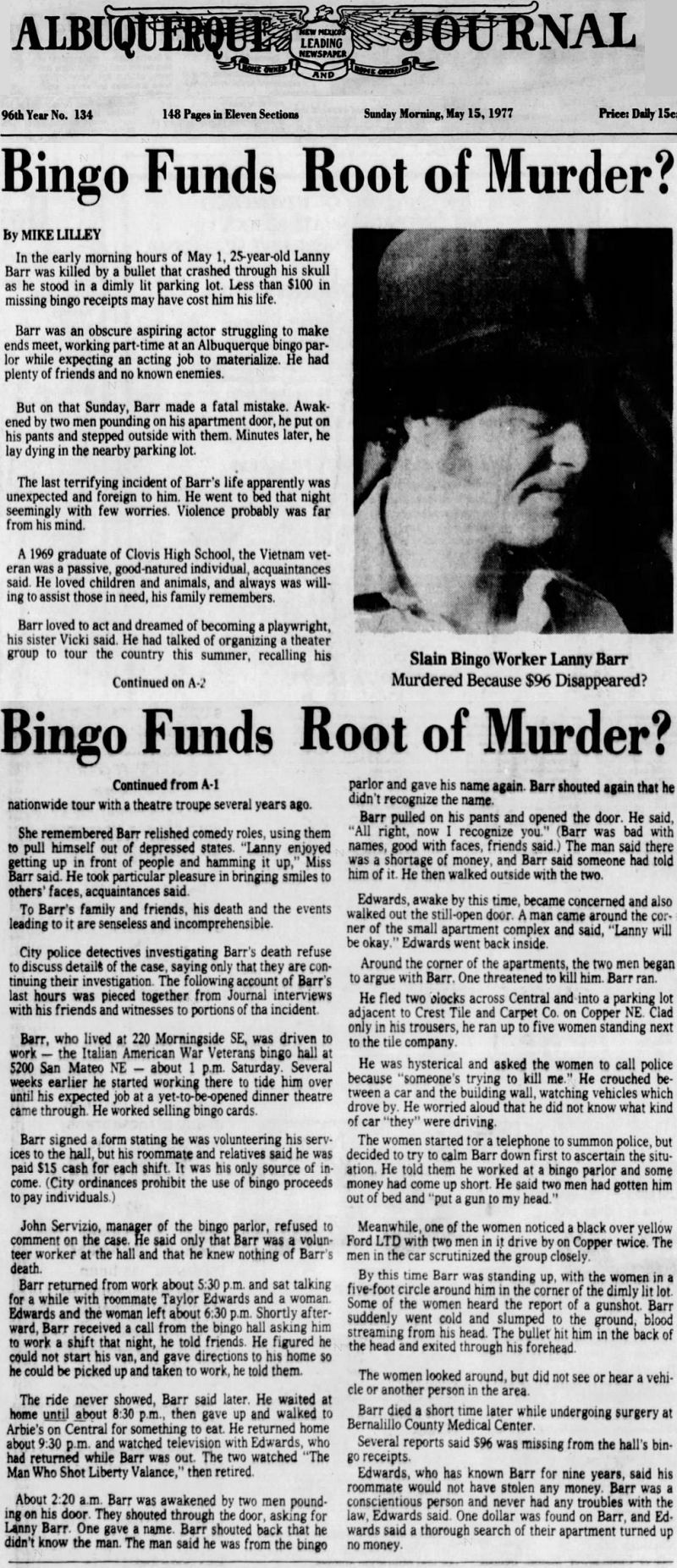


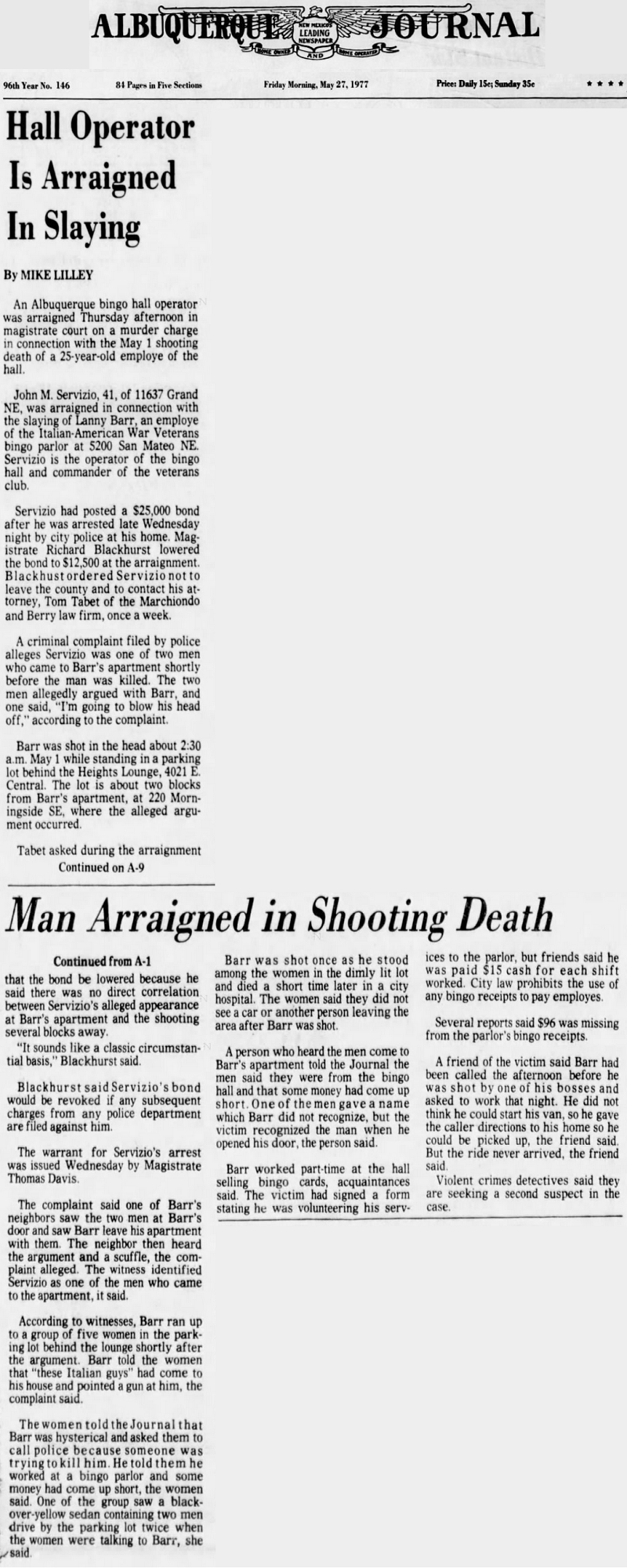
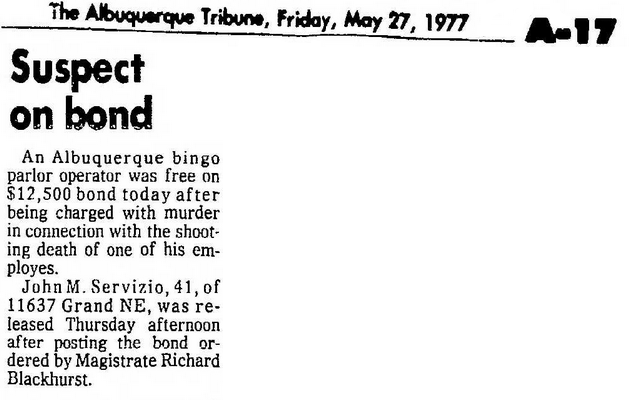

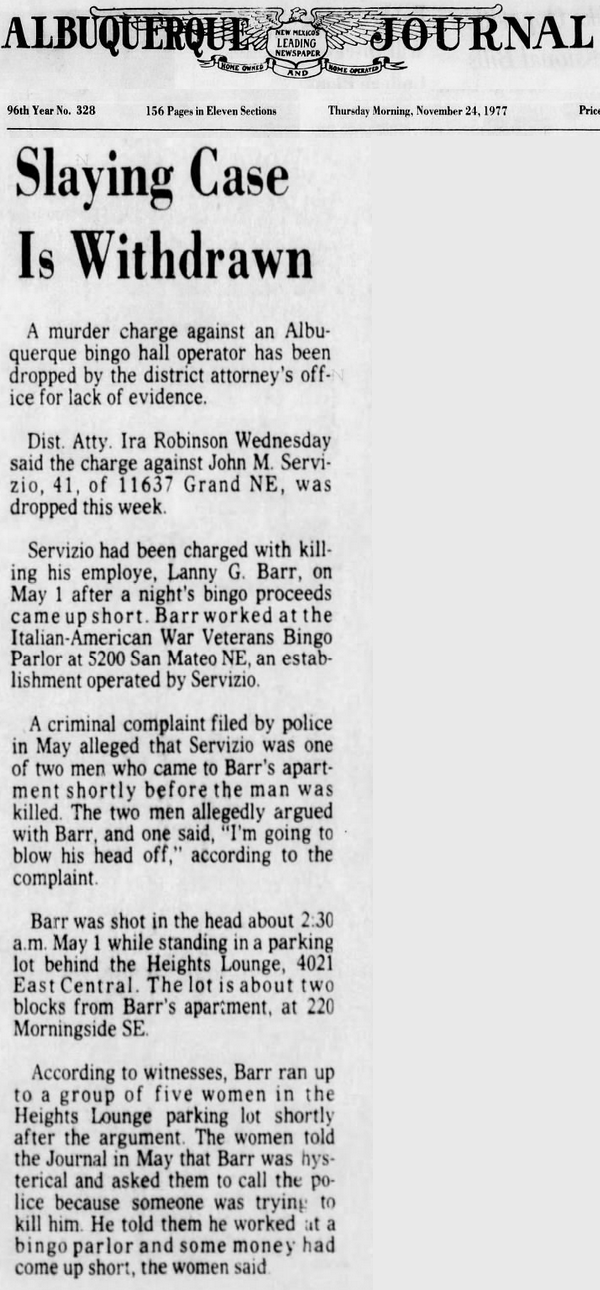

Is that too blurry? Shall I try to help out?
|
Not promoter,
Servizio says
A man who was cleared
last week of murder charges and identified in court docu- ments as a wrestling pro- moter says he never has been a wrestling promoter. John Servizio, 41, of 11637 Grand N.E., was cleared of a murder charge pending against bond in Magistrate Court in connection with the May 1 slaying of Lanny Barr. Barr was an employee of Servizio’s at the Italian- American Bingo Hall, 5200 San Mateo N.E., and was al- legedly shot and killed after proceeds at the hall came up short. Servizio was charged with Barr’s murder and released on $12,500 bail. Thomas Taber, Servizio’s attorney, said in motions filed in court that Servizio has a business as a wrestling promoter. However, Servizio told The Tribune that he never has been a wrestling promot- er. While Servizio was free on bond, two magistrates re- leased him to travel beyond the county because Taber told them Servizio was a wrestling promoter. |


Let’s skip ahead a few pages:



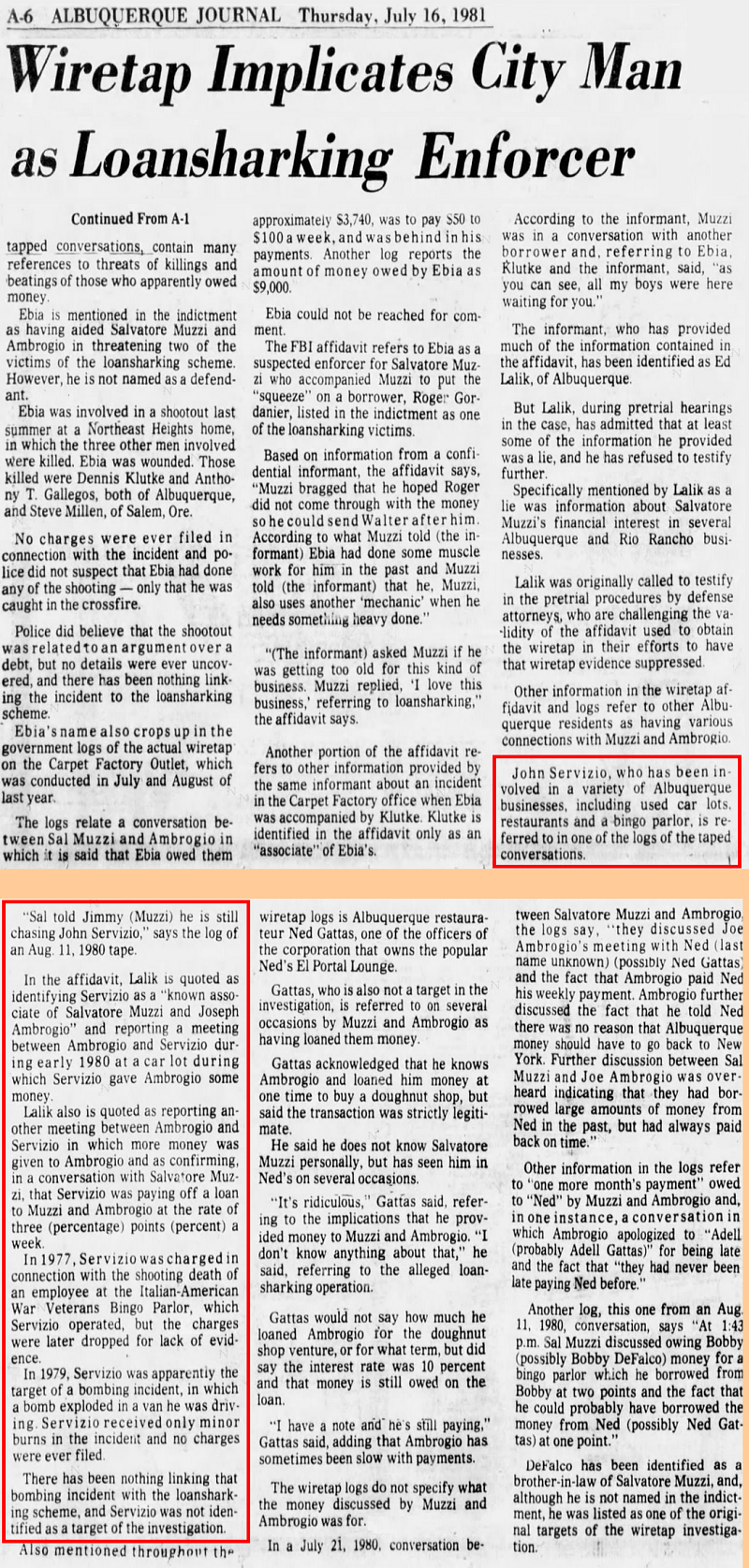


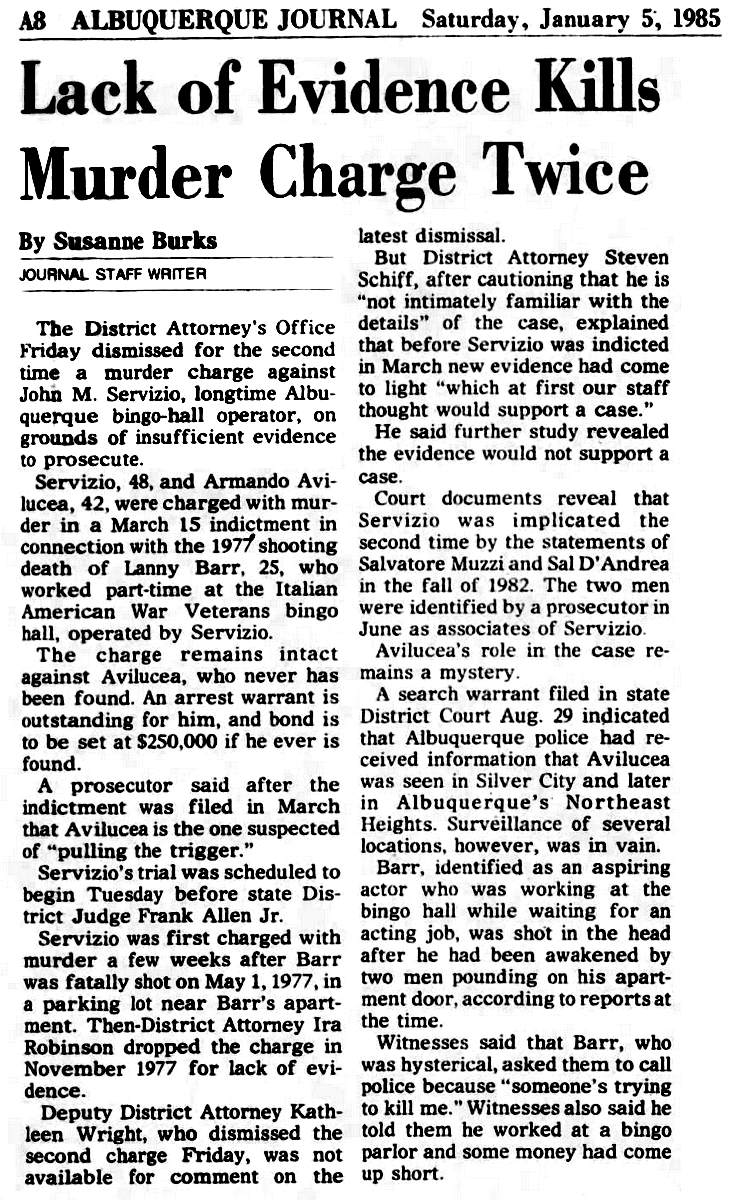




If you would like to read a little bit more, and if you have subscriptions to Newspapers.com and NewspaperArchive.com, here ya go:
I kept working.
In Albuquerque, you take what you can get.
Or else you don’t get nuttin’.
The
Simplex XL
picture heads had melted horrifyingly, because someone, at some time in the past,
had left the
Strong Excelite 135 carbon-arc lamphouses on with the dowsers open while the other parts of the machine were shut off,
and he (I exhibit my extreme bigotry by insisting that it was a he, because no she would do anything so stupid)
simply let the carbons burn all the way out,
until the metal casings on the picture heads were dripping globs.
The exhaust for the lamps was surely rotted through, and there was nothing I could do about it,
because I had no access to the roof, and I had no knowledge of how to repair ductwork and exhausts anyway.
Oh, I guess I could have searched around for a ladder and clambered my way up to the roof if I had really put my mind to it,
but even if I had managed to get up that high, what on earth would I have done?
I knew what I was going to see: rusted ducts filled with holes.
What could I do?
I had no money to hire someone to replace it all.
What was the use?
Every time there was the tiniest breeze, the dichroic reflectors cracked more and more.
Then, of course, the glue dried and so I had to scrape the old glue off and apply new glue, every week.
I spent half my time there gluing the reflectors back together every night.
The carbon ribbons were so old and so rotted that they were hanging together barely by a thread.
With my own money I purchased replacements.
The silver clamps for the positive rods were so scored and so pitted, probably by people cleaning them with hardened-steel chisels
and with hard wire brushes, that I was surprised that there was sufficient contact to strike an arc.
The plumbing in the restrooms constantly backed up, leaving large pools of urine and fecal matter ankle-deep on the floors.
Everything was filthy.
The outdoor staircase to the booth was rotted wood that was ready to give way.
The booth and the screen were originally Academy 1:1.375, but not anymore!
Now they were 1:2.00.
Wider films had the sides lopped off.
Taller films had the tops and bottoms lopped off.
I thought I might be able to fix that partly by using only the backups of the anamorphic lenses,
but I couldn’t, because they were not anamorphic lenses.
They were reverse anamorphic lenses,
which did not stretch the picture out to twice its width,
but squashed the height to half.
The tube pre-amp was on its last legs,
and the power amp would sometimes run so hot that the tubes turned blue.
We had a backup power amp, and so, during the ten-minute intermission,
I would kill the sound, let the intermission reel run silent,
and swap out the amp, only to discover that the backup was every bit as bad.
I tried every which way to fix it, but I am not an electrician.
I know (knew) a little bit, but not nearly enough, darn it!
I was worried that the entire sound system would blow one night.
That never happened, though.
Text: Copyright © 2019–2021, Ranjit Sandhu.
Images: Various copyrights, but reproduction here should qualify as fair use.
If you own any of these images, please contact me.
Images: Various copyrights, but reproduction here should qualify as fair use.
If you own any of these images, please contact me.